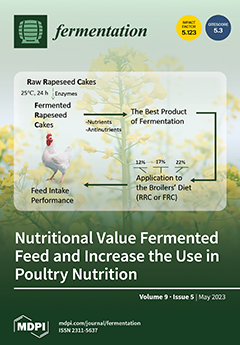A positive effect of flaxseed mucilage (FSM) addition (at concentrations of 0.1, 0.2, and 0.4%) to MRS and milk whey nutrient medium on the survival, auto-aggregation, hydrophobicity, adhesive, and antioxidant properties of
L. bulgaricus, L. fermentum AG8, and
L. plantarum AG9 was shown.
[...] Read more.
A positive effect of flaxseed mucilage (FSM) addition (at concentrations of 0.1, 0.2, and 0.4%) to MRS and milk whey nutrient medium on the survival, auto-aggregation, hydrophobicity, adhesive, and antioxidant properties of
L. bulgaricus, L. fermentum AG8, and
L. plantarum AG9 was shown. It was found that the AG 8 strain became less sensitive to 7% NaCl concentrations (the cell survival rate in the experiment with 0.4% flaxseed mucilage increased by 10% compared to the control). Cultivation in the presence of FSM led to an increase in auto-aggregation, especially in the case of
AG8 (from 60 to 85%) and
AG9 (from 50 to 80%) strains, and an increase in hydrophobicity was seen: for
L. fermentum AG8, it was from 30% to 62–72%, for
L. fermentum AG9 from 30% to 35–42%, and for
L. bulgaricus from 20% to 30%. The adhesive properties of the
L. fermentum AG8 and
L. plantarum AG9 cells increased from 0.472 to 1 nN (nanonewton) and from 0.630 to 2.5 nN, respectively. The presence of flaxseed mucilage increased the total phenolic content in cell-free supernatants after 48 h of cultivation. The concentration of 0.1–0.2% FSM increased the OH-scavenging activity of milk whey nutrient medium cell-free supernatants of strains
AG8 and
AG9 by 7–10%. Flaxseed mucilage can serve as a promising bioactive additive that elevates antioxidant activity, increases the resistance and survival of
Lactobacillus cells in the gastrointestinal tract, and leads to the synthesis of lipase and α-glucosidase inhibitors. The co-culture of these lactic acid bacteria in the presence of FSM and milk components in the form of whey leads to the synthesis of lipase and α-glucosidase inhibitors more than the culturing on de Man, Rogosa, and Sharpe broth.
Full article





